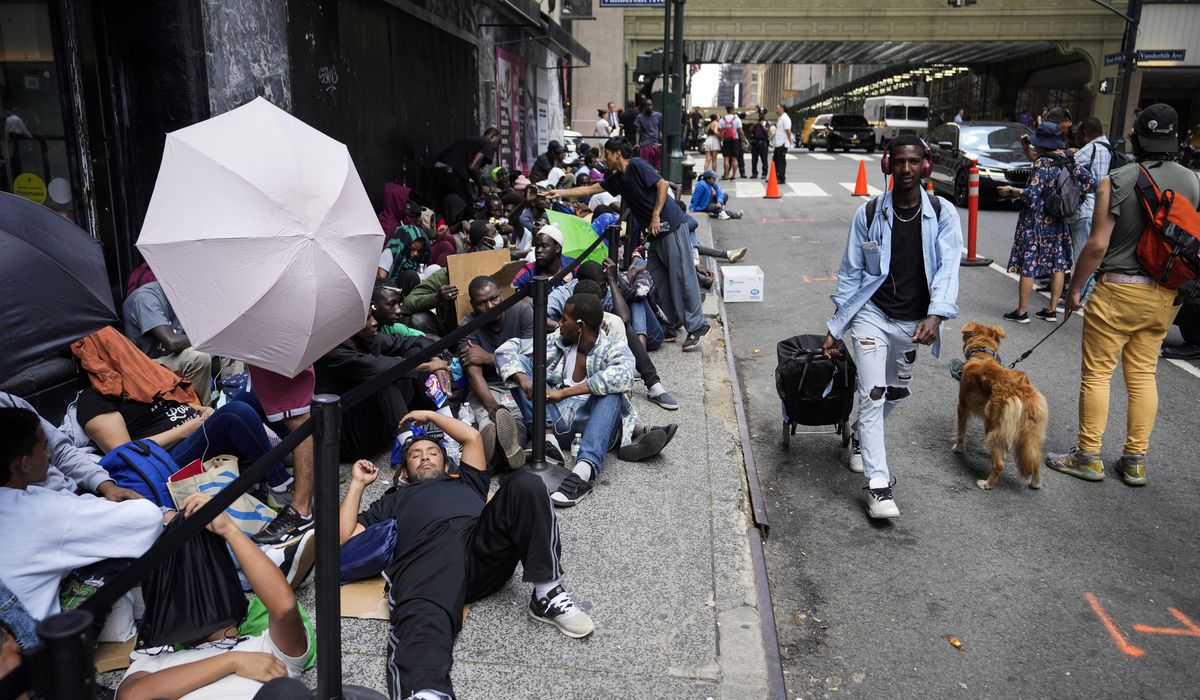


The illegal immigrants who streamed into New York City over the past four years led to an increase in crime near the hotels where they were housed, according to a new academic study that lends some credence to President Trump’s claims of a Biden migrant crime surge.
William LeRoy, an incoming professor at Charles University in Prague, crunched crime report data around the hotels where the migrants were being placed. He found that arrests of Hispanics — the dominant demographic of the largely Venezuelan newcomers — rose in the immediate areas around the hotels.
The big increase came in lower-level thefts.
“The baseline increase in Hispanic arrest rates is driven primarily by cash-generating offenses, such as petit and grand larceny, indicating that economic hardship is a leading factor behind criminal behavior,” Mr. LeRoy concluded.
He said the increases seemed to be tied to the lack of job prospects for the new arrivals.
Mr. LeRoy looked at zip codes where new migrants showed up in city-funded housing, then compared that to crime reports, using Hispanics as proxies for illegal immigrants. He said there was a 5.5% increase, relative to the average, in the percentage of Hispanic arrests starting with the arrival of the first bus of migrants sent in August 2022 by Texas Gov. Greg Abbott.
The study lends credence to the angst New Yorkers had expressed over the migrants flooding their city under President Biden, and it challenges the assurances of immigrant-rights advocates who dismissed crime fears as unfounded.
Residents from Denver to Chicago to Boston complained of increased crime associated with the new arrivals, but New York drew outsized attention, both because of its prominent welcoming policies and the sheer number of migrants taking advantage of it.
All told, the city said it received nearly 230,000 migrants from the spring of 2022 through the start of this year. About 45,000 of those were sent on buses by Mr. Abbott, who was looking to spread Texas’s border-state pain to others.
High-profile crimes shocked residents, including the beating of two New York Police Department officers outside a migrant hotel and reports of migrants roaming the streets on mopeds, grabbing handbags and phones from pedestrians.
Mr. LeRoy said the latter was far more common in his data. Two-thirds of the crime increase he identified was tied to misdemeanors, and particularly cash crimes like larceny.
He said the lack of job prospects seemed to explain the crimes.
The newcomers, as illegal immigrants, were generally forbidden from holding jobs, but many tried to find work as day laborers. Mr. LeRoy said in locations that were near a Home Depot — a frequent gathering spot for illegal immigrants trying to hire out for a day’s work — the crime increase disappeared.
Mr. LeRoy used Hispanics as a proxy for illegal immigrants because there was no citizenship data associated with the crime reports. But he said it was a pretty safe assumption because of the demographics of the newcomers, who were heavily Latino and, in particular, largely Venezuelan.
Alex Nowrasteh, a Cato Institute scholar who has studied migrants and crime, expressed concern with drawing that equation.
“The author acknowledges this, but this undermines the paper’s claims,” he said.
It’s not clear how much the findings affect the broader debate about illegal immigrants and crime.
Mr. LeRoy said the poor economic conditions that he argues spurred the increase in crime might not apply to longer-term illegal immigrants who have either managed to secure a work permit or figure out a way to get a job in the underground economy.
Still, he said cities that saw influxes, particularly from busing, might have seen similar rises.
Mr. Nowrasteh, though, said the population Mr. LeRoy looked at is so particular — migrants who were bused or made their way to New York and who ended up in government-provided housing — that it can’t be extrapolated to other illegal immigrants.
But Steven Camarota, research director at the Center for Immigration Studies and a regular debater with Mr. Nowrasteh on migrant crime research, said Mr. LeRoy’s findings make sense.
“It is not surprising that the arrival of migrants, often men, in a place where they have few ties will be associated at least in the short term with an increase in crime,” Mr. Camarota said.
“This is one of those sorts of social disorder things that comes with high levels of immigration, and of course, it might have continued but for the cutting off of the flow,” he said.
• Stephen Dinan can be reached at sdinan@washingtontimes.com.
